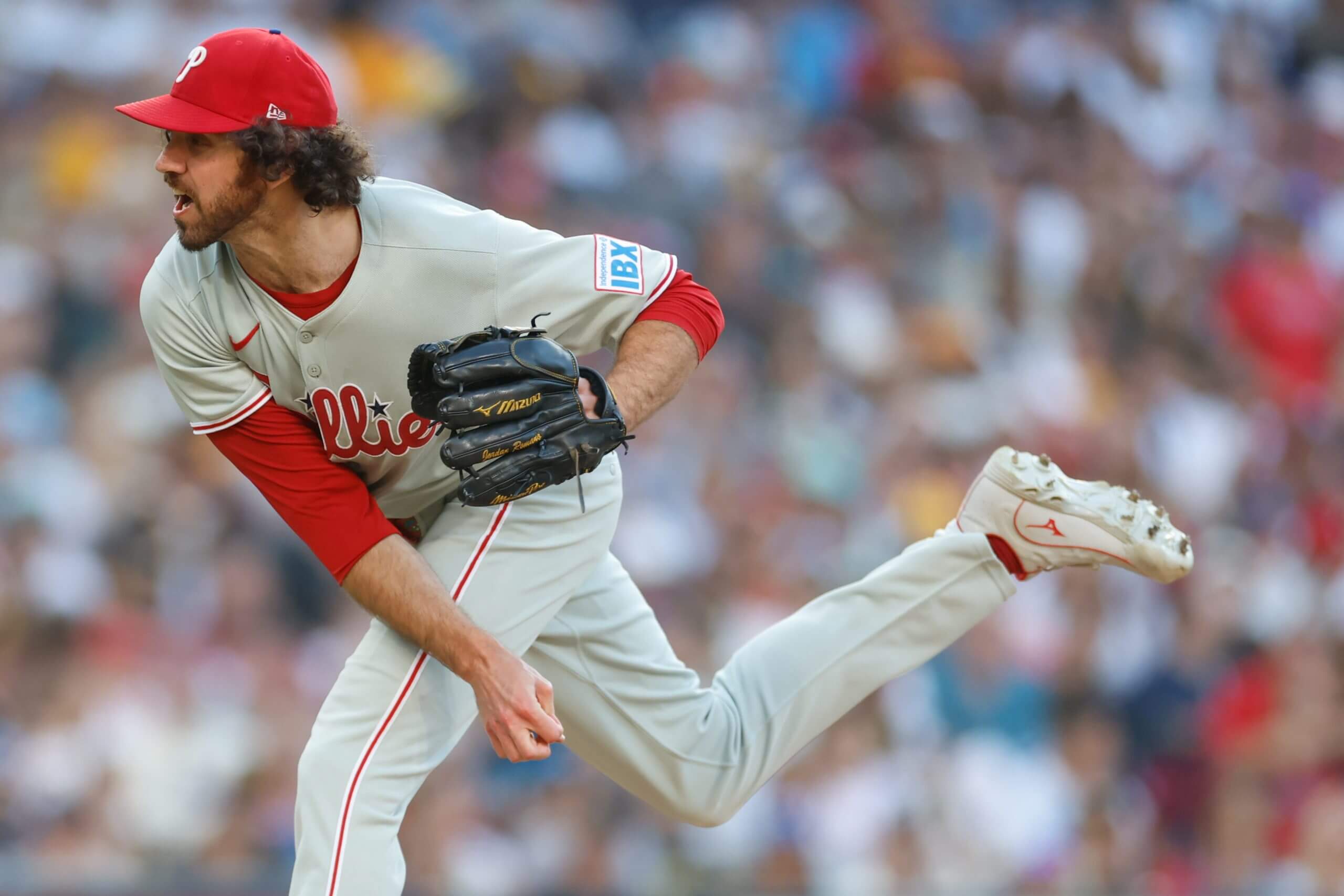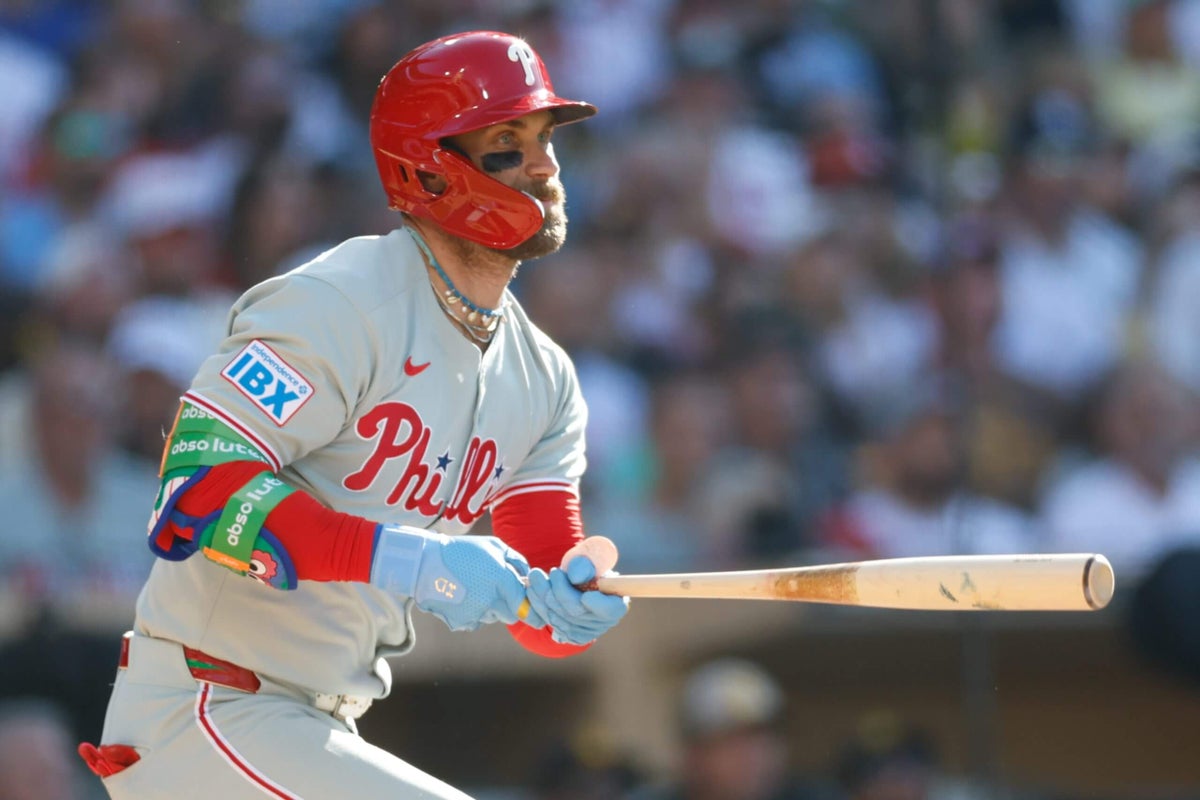The Phillies are in first place by half a game entering the second half of the season.
It has not been easy. There has been missed time: Bryce Harper and Aaron Nola on the injured list, José Alvarado suspended for using a performance-enhancing drug. There have been gritty wins with less power. There have been bullpen blowups, outfield struggles, trouble with offseason additions.
Still, the Phillies are in first. When they kick off the second half against the Los Angeles Angels on Friday, so begins a 66-game sprint toward reaching October.
Here are three storylines to watch the rest of the way.
Paying for a tough offseason
Jordan Romano has a 7.29 ERA and 1.500 WHIP with the Phillies. (David Frerker / Imagn Images)
At the halfway point, the Phillies are experiencing some déjà vu.
They will head into the second half prepared to shake up the same groups as during last year’s trade deadline and the offseason: the outfield and the bullpen.
The club’s window is narrowing. Additions are imperative. Perhaps the biggest question entering the second half: Just how aggressive will the Phillies be at the deadline? Per recent reporting in The Athletic: very.
Andrew Painter, the organization’s prized pitching prospect, remains untouchable. But for non-rentals, most everyone else could be available. It is the price of an offseason gone awry, when the Phillies acquired three bounce-back candidates in left fielder Max Kepler and relievers Jordan Romano and Joe Ross.
They have not bounced back. The enduring image of Romano is of him crouched over, unable to bear watching his mistakes fly. Kepler has struggled in a platoon, saying he expected to be an everyday left fielder this season. Ross has allowed 11 runs and walked eight across 13 2/3 innings since the beginning of June. Blame for the Phillies’ shortcomings extends well beyond the offseason acquisitions, but their meager production is impossible to ignore. The trio have combined for 0.1 WAR, according to FanGraphs.
Now the Phillies seek bullpen help and a right-handed bat entering the deadline. An outfield shakeup could happen, too, but it might be adding No. 3 prospect Justin Crawford rather than an external option.
Many contenders seek similar pieces. Trading from the top-heavy farm system could give the Phillies the upper hand, especially as they look to upgrade a bullpen that will be without Alvarado in the postseason and has posted these numbers since his suspension on May 18:
• 4.12 ERA (18th in the majors)
• 7.57 K/9 (27th in the majors)
• 19.4 K% (28th in the majors)
• 4.53 FIP (27th in the majors)
• 1.39 WHIP (23rd in the majors)
Outfield adventures
The Phillies’ outfield is a problem.
Perhaps the most dire statistic: minus-24 Defensive Runs Saved, which places Philadelphia 29th in MLB — ahead of only the Colorado Rockies (minus-31). The Phillies also rank 29th in outs above average, with minus-14. The group has not been pretty on offense, either; Philadelphia’s outfielders are 25th in MLB in OPS (.685) and 18th in on-base percentage (.310).
There have been some tweaks along the way, including a brief attempt to bench right fielder Nick Castellanos for defense late in close games — though last week in San Francisco, manager Rob Thomson said he likely would not do so again soon. Kepler fell to eighth in the batting order on Saturday before sitting for Sunday’s game, marking the first time he sat against a righty starter all season.
Bigger changes could be on the horizon. Among the potential solutions: trading Kepler or center fielder Brandon Marsh, both of whom have generated inquiries, major-league sources told The Athletic. Their value would be low, but at least Marsh has two-plus years of remaining team control.
Kepler, a $10 million offseason addition, has batted .210 with a .678 OPS in 85 games with Philadelphia. Marsh has turned it around after a sluggish start to the season and a hamstring injury, hitting .303/.364/.419 since returning May 3.
Any departure could clear a spot for Crawford, who has batted .353 with an .886 OPS since the beginning of May with Triple-A Lehigh Valley. Power remains a question, however, as Crawford has two home runs and three triples in 339 plate appearances this season.
At the least, Crawford could provide a spark to an outfield that needs one.
What could happen if Bryce is Bryce?
Harper is known for Capital-M moments, of which there have been few this season.
He slashed .237/.354/.428 across his first 40 games, seeing the lowest rate of fastballs in his career. Then he shaved his head and subsequently hit .360 with a .961 OPS in the next 14 games. But a hit-by-pitch on May 26 and an unrelated, three-week stint on the injured list (right wrist inflammation) halted that momentum.
It was an atypical first half for Harper. But he went 8-for-23 on last week’s West Coast trip, including tallying four extra-base hits in a game for the first time in his career on July 9. It was the punctuation mark of a game that the Phillies won 13-0. Should Harper build on this energy in the second half, he could pick up an offense that has been methodical and power-less at times.
More than halfway through the season, that might be what the Phillies are: adept at manufacturing runs and the fundamentals in spurts, but not at hitting for power. They have proven they can win games in this fashion, whether grinding out Sunday’s 2-1 win against the San Diego Padres or Otto Kemp bunting for the first time in professional baseball to power a Phillies win in his home debut.
Kyle Schwarber (.247/.378/.545) and Trea Turner (.289/.343/.433) picked up the pieces amid Harper’s struggles and absence. But a boost from the club’s superstar would be welcome as Philadelphia looks to win the division for the second straight season.
(Top photo of Bryce Harper: David Frerker / Imagn Images)
